This 1970 1/2 Chevrolet Camaro is frill-free and totally amazing

The Trains, Planes, and Automobiles car show held every September in Geneseo, Illinois—home of my Packard-restoring buddy, Dave Mitchell (and whose 1953 Buick Super Estate wagon was featured here last year)—is a great event. There’s always a wide variety of interesting and uncommon classics: I’ve spotted an ex-service-station Corvair Rampside pickup, a Sunbeam Alpine roadster with factory hardtop, a 1960 Chevrolet Nomad station wagon, a mint-condition 1977 Caprice Classic Landau Coupe, Studebakers, Porsche 356s, you name it. And this remarkably original, non-RS, non-SS, non-Z28, plain Jane and totally amazing 1970.5 Camaro coupe.

The ’70.5 Camaro (so called because the extremely collectible 1969 Camaro continued well into the 1970 model year as an “early 1970” model) was a surprising, Italianate twist to Chevy’s pony car. Gone was the three-box 1967–69 styling, replaced with Bill Mitchell’s interpretation of classic Italian lines—Ferrari in particular. I think it’s safe to say no one was expecting such a sleek, sexy design. After all, its main competitor, the Mustang, had stuck to its 1964 formula and overall appearance despite two redesigns by 1970.

Today, untouched cars like today’s subject are becoming increasingly uncommon. Many surviving Camaros, Mustangs, Barracudas, and Challengers are modified in a plethora of ways. Base model, mint green Camaros or root-beer-brown Mustang Grandes are painted red. Then someone shoehorns in a crate engine and adds all the items that were reserved for a fraction of the original production run: rally wheels, spoilers, scoops, stripes, Hurst shifter, power windows, sport mirrors, and AM/FM/eight-track. Others get the full restomod treatment. Such modifications are all fine and good, but they have made cars like today’s subject all the more interesting—and scarce.

I appreciate original cars much more. Individual Mustangs and Camaros, when new, were quite different from car to car; you were unlikely to see two that were exactly the same. Back then, a broad color chart and a deep options list were the rule.
An example: My dad’s first car was a straight-six-powered 1965 Mustang convertible. Poppy Red with white stripes, white interior and top. Deluxe wheel covers with the little knock-off spinners. Whitewalls. It was sharp, it was sporty–and it was slow. It had been purchased new by my grandfather’s secretary and Grandpa Bob rightfully deduced that he couldn’t get into too much trouble with it. As Dad told me, it was all show and no go, but that’s largely how it came off the line new—though he did add the white, GT-style rocker-panel striping.

So it goes with the many pony-car rejuvenations today, and so I initially passed over this Camaro while completing my first circuit of the show, assuming incorrectly that it was yet another Z28 or Z28 clone. As it turned out I was 100 percent wrong.

On my second lap I actually looked at it and noticed the baby moon hubcaps. “Oh, that’s cool.” Then I saw they were factory hubcaps, and, holy crap: It had the standard six cylinder engine! Inside was an all-business black interior with the standard vinyl buckets and a column-mounted two-speed Powerglide automatic. No console. Very interesting, as the late, great Arte Johnson frequently said.

Who would order such a car? As I discovered, the original owner was a lady who just wanted a sporty car, but one with no frills. This car is quite frill-free, with its standard 155-hp six, Strato-Bucket seats, carpeting, and Astro Ventilation.
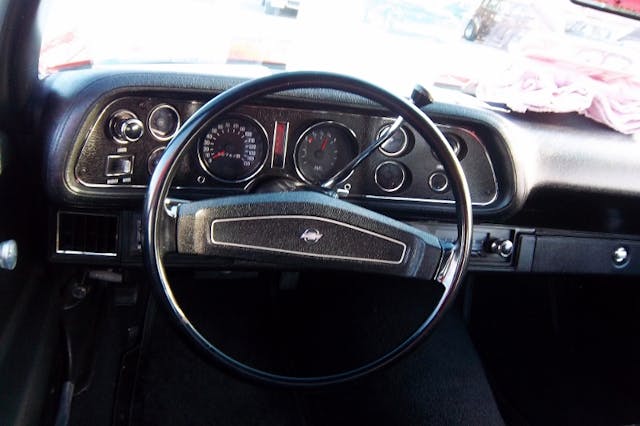
The few options on this car include a tinted windshield, AM radio, and whitewall tires: no console, no A/C, no power windows, and no sport mirrors. In other words, none of the usual muscle car Camaro stuff, and no aftermarket wheels or other rickrack. I immediately loved this car.

Even in basic form the ’70.5 Camaro’s lines are still lovely. The lines are even cleaner without the air dams and spoilers. Those slim chrome bumpers, grille standing proud of the headlight bezels, that quartet of round taillamps—all lovely. And so different from the usual early ’70s Camaros seen at cruise-ins and car shows.

If it still looks good without any optional plumage to enhance its basic form, it’s a worthy vehicle, at least aesthetically. When you apply that standard to the 1970.5 Camaro and its corporate sibling, the equally sharp Pontiac Firebird, it still shines.
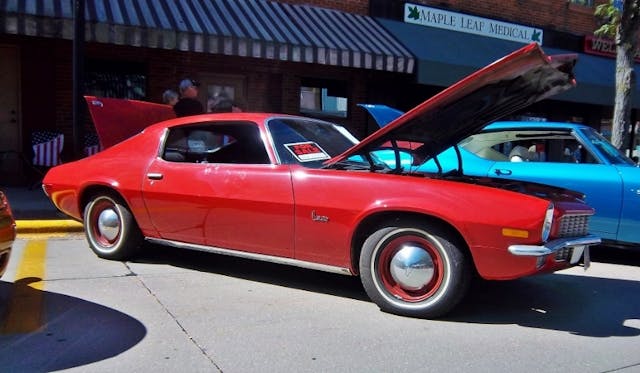
The man displaying this car back in Geneseo in September 2012 was the original owner’s nephew, and he was old enough to remember when his aunt brought the Camaro home. It was purchased at Cambridge Motors, in Cambridge, Illinois, a small town about a half an hour’s drive from the Quad Cities.
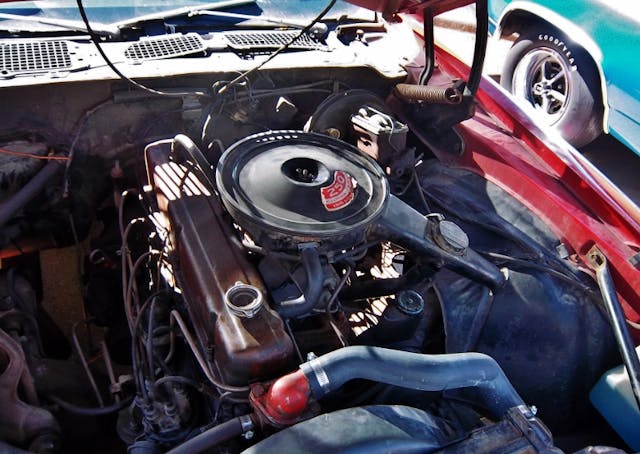
This car is an amazing time capsule, with original paint and engine. It only had 59,000 miles on it at the time. I did not begrudge him too much for asking ten grand. After all, where else will you find a car like this one? And it was rust-free, needed nothing, and was ready to rock and roll.

I can see the appeal of a car like this. This car, with its six-cylinder engine, Powerglide, and hub caps, is equipped like a plain-Jane Nova, but in a swoopy Bill Mitchell-designed Italian dress.
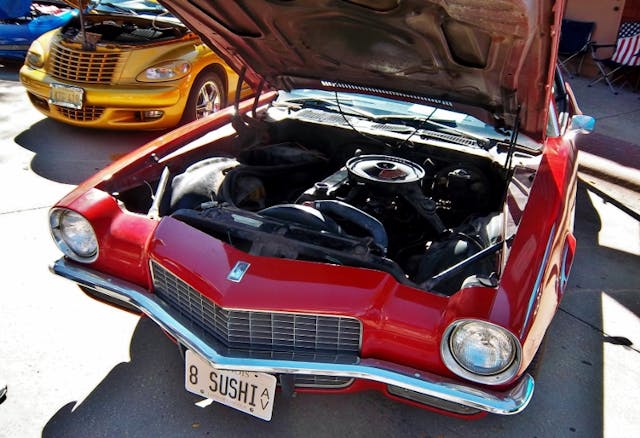
Kind of like the attractive lady librarian with the sensible shoes, unpretentious clothes, and tortoiseshell glasses. Even all those things can’t hide her inner beauty. So it is with this ’70 Camaro.
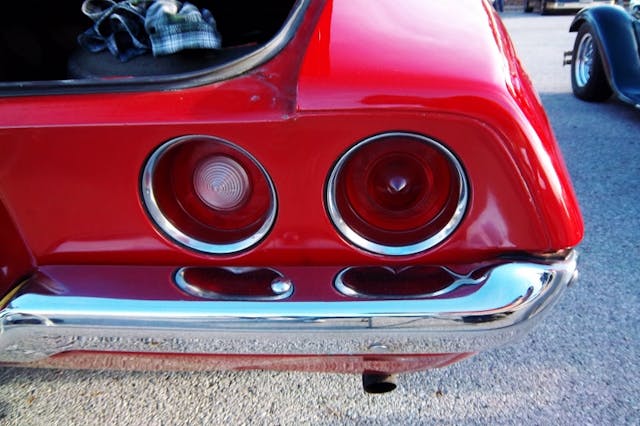
For an original car, it was in fine shape. Naturally, there were a couple of minor bumps and bruises, but that did not detract from what a nice car it was. All the cool details of these Camaros were still evident, like that V’d grille, fastback roofline, and smooth flanks.

It even still had the original trunk mat, which the owner’s nephew told me is very hard to find NOS these days. Could there be another ’70.5 Camaro in existence that is still equipped like this one? Perhaps so, but not many!
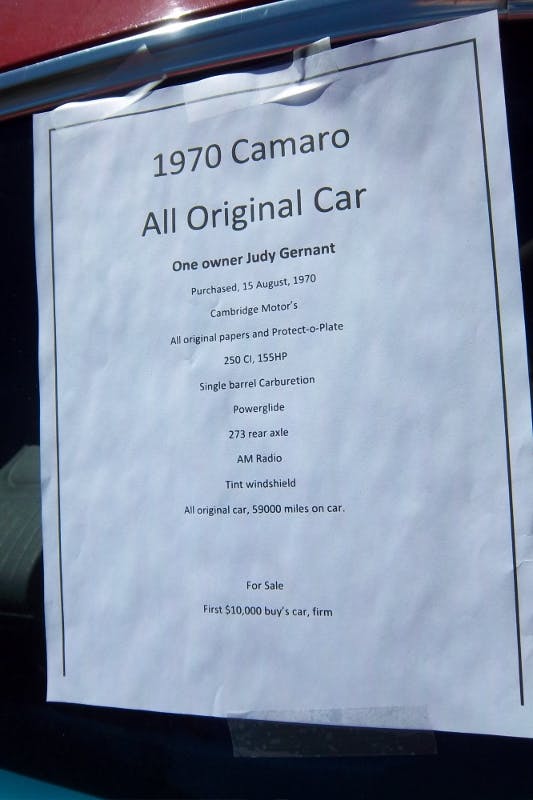
There may come a time when no one remembers that some pony cars and mid-size sporty cars were not muscle cars—not by a long shot. I know we’re already halfway there; on a recent TV show, someone mentioned a Ford Maverick as a muscle car. They appeared to be serious.

I see I’ve digressed again. Never mind! In any case, Camaros with the six were rare even when new. Out of 117,604 1970.5 Camaros produced, only 12,566 had the Turbo-Thrift Six. How many can be left?
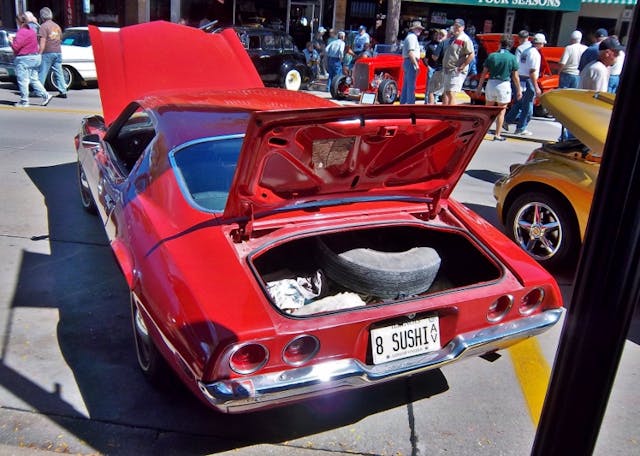
Not many, that’s for sure. At the time, I sincerely hoped that the next owner of this car would keep it as it is. That seemed to be borne out, as the pictures of the car with new blackwall tires were taken in September 2013, a year after I initially sighted this time capsule. Sadly, however, I haven’t seen it since. Hope she’s in good hands—and still the same.
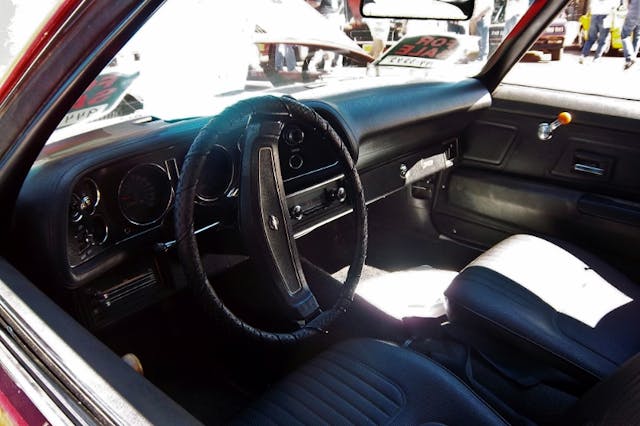


My car was 72 and 1/2 Z28 all factory 305 heads 388 cam 388 rear end factory headers register for 140 350 motor 650 quarters yet carburetor find it
Let’s find out where I can find another one
I know where one is , but he’ll only trade for a tri 5 Chevy of equal value.
Same red,black interior, dog dish hubcaps, inline 6.
Like to find another 72 and 1/2 Z28 experimental
Are all 1970 camaros considered to be 70 1/2?
GM never called them 70 and a half’s there is no such thing. They were 1970 model year Camaro’s. The next year model was a 1971,1972….you get the picture.